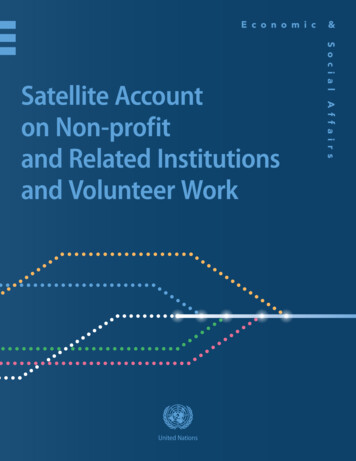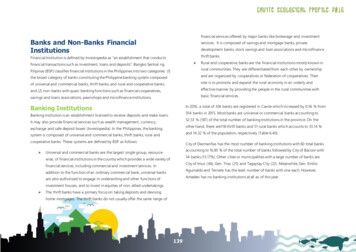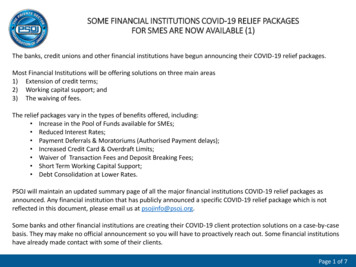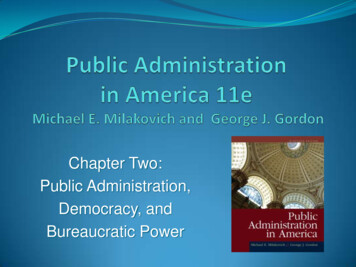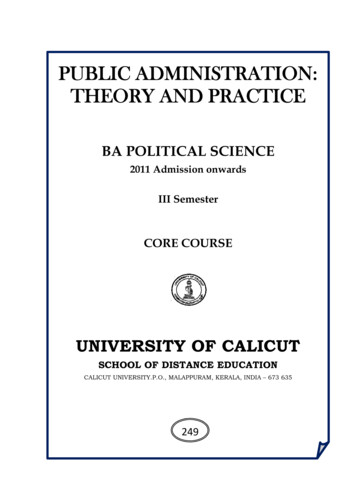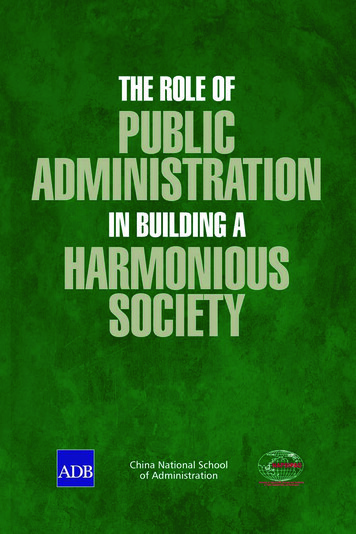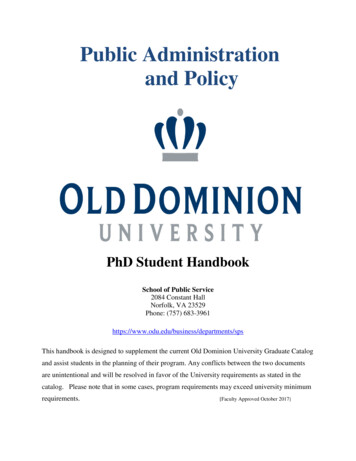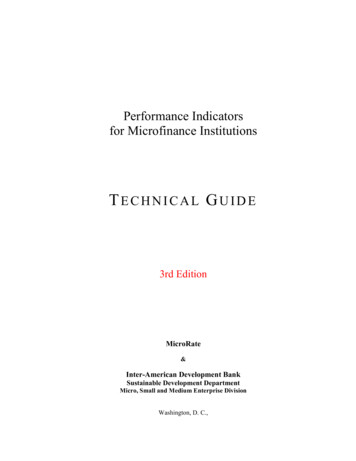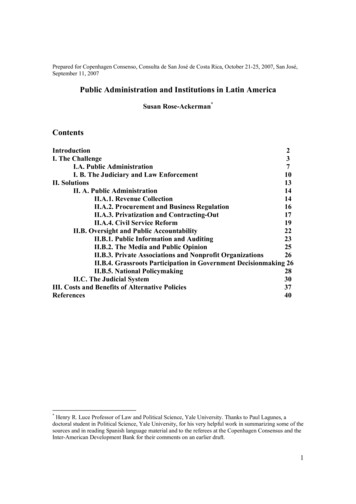
Transcription
Prepared for Copenhagen Consenso, Consulta de San José de Costa Rica, October 21-25, 2007, San José,September 11, 2007Public Administration and Institutions in Latin AmericaSusan Rose-Ackerman*ContentsIntroduction2I. The Challenge3I.A. Public Administration7I. B. The Judiciary and Law Enforcement10II. Solutions13II. A. Public Administration14II.A.1. Revenue Collection14II.A.2. Procurement and Business Regulation16II.A.3. Privatization and Contracting-Out17II.A.4. Civil Service Reform19II.B. Oversight and Public Accountability22II.B.1. Public Information and Auditing23II.B.2. The Media and Public Opinion25II.B.3. Private Associations and Nonprofit Organizations26II.B.4. Grassroots Participation in Government Decisionmaking 26II.B.5. National Policymaking28II.C. The Judicial System30III. Costs and Benefits of Alternative Policies37References40*Henry R. Luce Professor of Law and Political Science, Yale University. Thanks to Paul Lagunes, adoctoral student in Political Science, Yale University, for his very helpful work in summarizing some of thesources and in reading Spanish language material and to the referees at the Copenhagen Consensus and theInter-American Development Bank for their comments on an earlier draft.1
IntroductionMost Latin American countries have democratic constitutions, functioning bureaucracies,and professional judiciaries. The institutions are in place, but their operation varieswidely across the region. Some institutions function well in some countries, sometimessurpassing the performance of those in comparable, wealthier countries. Others, however,are plagued with waste and corruption, impose needless costs on the population, and donot accomplish their missions well. I highlight the most pressing problems in the regionand discuss potential solutions drawing on existing experiments and reform initiatives.Reform priorities ought to differ across countries. Although most occupy the middlerange on cross-country measures of corruption and government effectiveness and interms of economic well-being and growth, the key pressure points vary. I highlight goodand bad performers on a number of dimensions and argue that broad regional similaritiesimply that successes in one country can provide lessons for reformers elsewhere.I concentrate on public administration and the judiciary, but improvements inthese areas can complement other types of reform. For example, Latin Americandemocracies have traditionally had weak legislatures.1 If legislative capacity isstrengthened, it can play a stronger oversight role with respect to the executive. Similarly,if violence and organized crime make ordinary state functioning problematic, thenimproved law enforcement is a necessary condition for other types of reform to succeed.2Political realities determine whether a country enacts reforms in the first place andaffects the quality and sustainability of their implementation. Studies of state reform inLatin America from the colonial period to the present highlight the way the loci ofpolitical power influence which reforms are feasible and which can survive over time.3 Ideal with this issue only indirectly in discussing the design of reforms and the value ofimproving routes for citizen access and monitoring. My primary focus is on isolatingreforms that appear to have been successes with the aim of providing guidance to thosewilling to push for change.Reform of the public administration can take three routes: (1) reform of the statein its interaction with private citizens and businesses, (2) internal reform of the civilservice system to improve its professionalism and honesty, and (3) reforms that open upthe operation of government to oversight by those both inside and outside thegovernment. In discussing reform of the legal system, I concentrate on: (a) reform in theselection and performance of judges and their staff, and (b) reform of the legal system asa whole. If the judiciary can be reformed, then it not only will more effectively resolveprivate law disputes but can also play an oversight role vis-à-vis government—monitoring the performance of the public administration to be sure that public officialsobey both substantive and procedural law (Rose-Ackerman 2004a).Unfortunately, few reform options have been subjected to rigorous testing in theLatin American region. I highlight the studies that exist but stress the importance of1Spink (1999), Mainwaring and Shugart (1997), Moreno, Crisp, and Shugart (2003).Other challenge papers prepared for Consulta de San José de Costa Rica deal with strengtheningdemocracy and with combating crime and violence.3See Spink (1999) for an overview and critique of past efforts. Geddes (1994) shows how reform occurredin Latin American countries under grand coalitions of the major political parties. For the particular case ofrevenue authorities see Talierco (2001).22
setting priorities on a country-by-country basis and of considering reforms that have notyet been tested in practice. As Dani Rodrik argues, the search for uniform “blueprints” or“best practices” is an elusive quest. Rather, in each country, reformers need to isolate itsmost serious problems and design policies that fit that country’s situation (Rodrik 2006).There is much room for creative experimentation, but experiments should be carried outwith an evaluation component that produces quantitative measures of success or failure.Successes cannot be automatically reproduced elsewhere, but they will, at least, suggestoptions for reformers to consider.This paper begins by outlining the significant weaknesses of Latin Americanstates while highlighting cross-country differences. Obviously, many of the problems Iisolate will sound familiar to readers from other regions including wealthier societies, butI concentrate here on this one region in the hope that highlighting the variety ofexperience there can help understanding. The second section proposes responses to thesechallenging problems. Finally, the last section collects existing information on the costsand benefits of alternative policies.I. The ChallengeGlobal cross-country research supports the claim that institutions matter for growth anddemonstrates that poorly functioning government institutions are associated with harmfuloutcomes.4 However, the consequences of weak institutions are difficult to distinguishfrom the causes. Take the controversy over corruption, for example. Corruption limitsgrowth, but low growth encourages corruption and makes it difficult to improvegovernment effectiveness.5 There are feedback mechanisms from low growth to highcorruption and, conversely, from high growth to low corruption; the growth processcannot begin unless reasonably well-functioning institutions are in place. Other empiricalregularities raise similar problems of causation. High levels of corruption are associatedwith greater inequality and poverty, a larger shadow economy, a smaller and lessproductive capital stock, and distorted allocations of public and private resources.6 Thesefactors are consequences of corruption, but they could also be causes. In any case,corruption standing alone is not the essential problem. Rather, corruption symbolizes andhighlights underlying weaknesses in the operation of the state and its interactions withcitizens and businesses. I concentrate here on an important class of governmentinstitutions that can produce either a competent and fair state if they function well or acorrupt, unfair, and ineffective state, if they operate poorly. My focus is the operation ofboth the public administration and the judiciary, leaving to another challenge paperdiscussion of electoral politics and the interactions between elected presidents andlegislatures.The Latin American countries are mostly in the broad middle range both in percapita income and well-being and in measures of government effectiveness and4Lambsdorff (2006); Kaufmann, Kraay, and Mastruzzi, (2006); Feld and Voight (2003); Rivera-Batiz(2002).5For a debate on the issue of causation and other questions raised by the cross country research see theinterchange in the Journal of Politics in 2007: Kurtz and Schrank, (2007a, b), Kaufmann, Kraay, andMastruzzi (2007a, 2007b).6See Rose-Ackerman (2004b) for citations to the relevant literature.3
institutional quality. Figure 1 shows a generally positive relationship in the regionbetween high government effectiveness, on the one hand, and high levels of the UNHuman Development Index (HDI), on the other.7 A similar pattern holds for corruption.However, there are countries that do not fit the pattern. For example, measured by theHDI, Chile is getting little marginal benefit from its low corruption and high governmenteffectiveness compared to other relatively high-performing countries.8 Conversely,Argentina reports high corruption and low confidence in the bureaucracy but is inrelatively good shape economically. Figure 2 relates the Transparency InternationalCorruption Perceptions Index to the ten-year growth rate of real GDP. Here the pattern ismixed. Those with the worst corruption are among those with the lowest growth rates, butsome countries, such as Uruguay (a relatively wealthy country), have low growth and lowcorruption. Conversely, some high-growth counties are quite corrupt. For countries in themiddle range, there is no clear pattern in the raw data. Thus, although bearing out thegeneral claim that institutions matter for economic and social well-being, the figuressuggest the need to disaggregate country-level summary indices to see what is happeningin particular sectors and to analyze the underlying causes of economic growth.[Figures 1, 2]Beyond simple measures of well-being such as the HDI, government competenceand fairness affect people’s daily lives in other ways. Of particular importance is thebasic level of security and the effectiveness and fairness of law enforcement. The crosscountry data, summarized by Edgardo Buscaglia, suggest that countries with high levelsof corruption, a signal of a weak and ineffective state, also have high levels of organizedcrime and of public insecurity, and this pattern applies to the Latin American countries inhis data (Figure 3). However, within the region there is considerable variation. Althoughorganized crime and corruption generally go together, Columbia’s levels of organizedcrime is especially high relative to its level of corruption. In other work, Buscaglia showsthat public insecurity is generally related to low-level corruption, but that some countries-Costa Rica, Paraguay, Brazil, Bolivia and Argentina—report similar levels of publicinsecurity but widely different levels of low-level corruption.9[Figure 3]Another negative effect of corrupt and ineffective government is the lack ofpolitical legitimacy that they produce (Anderson and Tverdova 2003). High levels ofadministrative corruption are linked with negative perceptions of bureaucratic quality(Buscaglia and van Dijk 2003:18). This effect may be over and above the impact oneconomic well-being and personal security. Surveys carried out in four Latin American7Corruption is measured using Transparency International’s Corruption Perceptions Index (TI-CPI) thatranges from zero to 10 with high numbers representing lower levels of corruption. Governmenteffectiveness is an index compiled by the World Bank Institute from various sources. The HumanDevelopment Index (HDI) is a weighted average of GDP per capita and measures of education and health.8It is, however, important to recognize that that result is partly a function of the way the HDI is calculated.Income enters logarithmically so that its marginal impact on the index falls at higher incomes.9The corruption levels are defined as follows and refer in particular to organized crime corruption of stateinstitutions: Primer Nivel: Corrupcion aislada; Segundo Nivel: Frecuente corrupcion en la misma agencia;Tercer Nivel: Penetracion de la estructura a niveles operativos e intermdios; Cuarto Nivel; Infiltracion de laestructura a nivel de mandos; Quinto Nivel; Infiltration en el espacio politico. Detailed definitions areprovided in Buscaglia and Gonzalez Ruiz (2006).4
countries (El Salvador, Nicaragua, Bolivia and Paraguay) in 1998 and 1999 showed thatthose exposed to corruption had both lower levels of belief in the political system andlower interpersonal trust (Seligman 2002). In Nicaragua, respondents were asked if thepayment of bribes “facilitates getting things done in the bureaucracy.” Interestingly,those who agreed that corruption gets things done were less likely to believe in thelegitimacy of the political system (ibid. 429).To get a better sense for government functioning, we need to consider morefocused measures that go beyond perceptions of “corruption” and governmenteffectiveness. To begin, Table 1 collects several indices of the quality of government, twoof which are included in the figures above. Chile, Uruguay and Costa Rica top thegovernance rankings, and Paraguay and Venezuela are near the bottom.10 Somecountries’ rankings, however, suggest the need for in-depth country-level analyses. Forexample, El Salvador is reputedly less corrupt than most others in the region, but it rankslow in government effectiveness and the rule of law. In contrast, Guatemala, one of theleast developed countries, is thought to be very corrupt and to have a poor propertyregime, but it ranks quite well in one measure of government effectiveness and in the ruleof law.11 Four major countries in the region—Columbia, Brazil, Mexico, andArgentina—are at or above the regional median on all measures. Peru, althoughcomparable to Mexico on the corruption index, appears to have an especially ineffectivegovernment.[Table 1]A second way to compare countries is through the “Doing Business” measurescompiled by the World Bank and the International Finance Corporation (2006). Theseconcentrate on the legal costs imposed on business, not the entire operat
Reform of the public administration can take three routes: (1) reform of the state in its interaction with private citizens and businesses, (2) internal reform of the civil service system to improve its professionalism and honesty, and (3) reforms that open up the operation of government to oversight by those both inside and outside the government. In discussing reform of the legal system, I concentrate
